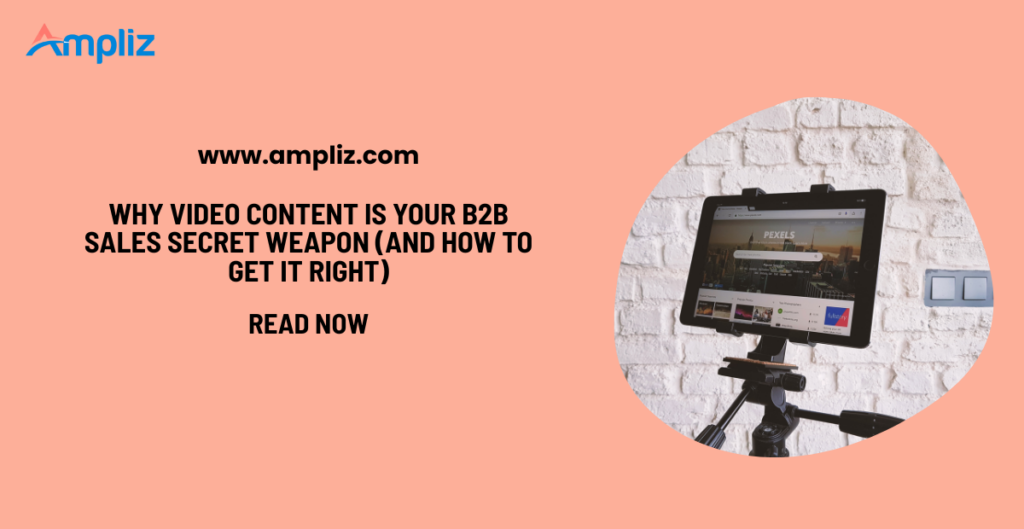Remember when B2B marketing meant white papers, cold calls, and maybe a PowerPoint if you were feeling fancy? Those days are gone. Today’s decision-makers are scrolling through LinkedIn during their morning coffee, watching explainer videos on their lunch break, and engaging with content that actually speaks to them like humans—not corporate robots.
Here’s the reality: video content isn’t just “nice to have” anymore in the B2B space. It’s become the difference between companies that connect with their audience and those that get lost in the noise. But here’s where most B2B marketers trip up—they either go overboard with production costs that would make Hollywood blush, or they put out content so bland it makes elevator music seem exciting.
The sweet spot? Creating authentic, valuable video content that resonates with your audience without requiring a film crew and a six-figure budget. Whether you’re a sales rep trying to stand out in a crowded inbox, a marketer building brand awareness, or a founder explaining your complex solution, video gives you something text and static images can’t: the ability to build genuine connection at scale.
In this guide, we’re diving into everything you need to know about leveraging video content in your B2B strategy—from understanding why it works so well to creating content that actually converts, and yes, the practical tools and techniques that make it all manageable for real businesses with real budgets.
The Data Doesn’t Lie: Why Video Dominates B2B Engagement
Let’s start with what the numbers tell us. B2B buyers are consuming video content at unprecedented rates. We’re not talking about a slight uptick—we’re seeing fundamental shifts in how purchasing decisions get made.
Decision-makers watch an average of 60 minutes of business-related video content per week. That’s an hour of someone’s valuable time dedicated specifically to video. More importantly, 70% of B2B buyers watch videos throughout their entire path to purchase, from initial awareness all the way through to comparing solutions and making final decisions.
But why? What makes video so effective in a space traditionally dominated by data sheets and case studies? It comes down to three core factors: efficiency, clarity, and trust.
Video condenses complex information into digestible formats. Try explaining a sophisticated SaaS platform in a 500-word blog post versus a 2-minute demo video—the video wins every time for comprehension and retention. Your prospects can see the interface, watch the workflow, and understand the value proposition without wading through paragraphs of text.
Beyond efficiency, there’s the trust factor. When buyers see actual people—whether it’s your CEO explaining company values, your customer success team walking through implementations, or clients sharing their experiences—they’re building relationships with your brand before ever having a conversation. That’s powerful in a B2B environment where trust is currency and switching costs are high.
The Video Content Mix: What Actually Works in B2B
Not all videos are created equal, and what works brilliantly for one stage of the buyer’s journey might fall flat at another. Let’s break down the types of video content that consistently deliver results in B2B contexts.
Product demos and walkthroughs remain the heavyweight champions of B2B video content. These aren’t slick commercials—they’re practical demonstrations showing how your solution solves real problems. The key is specificity. Instead of showing every feature your product offers, create focused videos addressing specific use cases or pain points. A 3-minute video showing exactly how your tool streamlines invoice processing will resonate more than a 10-minute tour of everything your platform can do.
Customer testimonials and case studies bridge the credibility gap better than any marketing copy ever could. But here’s the trick: the best testimonial videos don’t feel staged. Give your customers prompts, not scripts. Ask them about specific challenges, implementation experiences, and measurable results. The authentic responses—including pauses, natural language, and even the occasional “um”—build more trust than perfectly rehearsed statements.
Educational content positions your brand as a thought leader while providing genuine value. Think tutorial videos, industry insights, trend analyses, or how-to guides related to your space. This content serves dual purposes: it attracts prospects early in their research phase while establishing your expertise, and it supports existing customers by helping them get more value from your solution or improve their broader processes.
Personalized sales videos are changing the outreach game. Sales reps who send personalized video messages see response rates that crush traditional email outreach. We’re talking about quick, authentic videos where a rep addresses a prospect by name, references their specific company situation, and explains why they’re reaching out. It’s not scalable to millions, but for target account strategies, it’s gold.

Creating Video Content That Connects (Without Breaking the Bank)
Here’s where theory meets reality. You understand why video matters and what types to create, but the execution is where most B2B companies either overcomplicate things or undersell themselves. Let’s talk about practical creation.
Start with what you have. Seriously. The biggest barrier to video adoption isn’t lack of equipment—it’s perfectionism. Your smartphone camera is probably better than professional cameras from a decade ago. Natural lighting from a window beats complex lighting rigs for most business content. A quiet room and a $30 lavalier microphone will capture better audio than most built-in mics.
The secret isn’t production value—it’s preparation and authenticity. Before hitting record, outline your key points. Not a script (unless you’re naturally great at reading scripts, which most people aren’t), but bullet points covering what you need to communicate. This keeps you focused while allowing natural delivery.
For sales and marketing teams creating multiple videos, establishing simple recording setups makes consistency easier. Find a corner with good natural light, keep your background clean but not sterile (bookshelves, plants, or tasteful office décor work great), and use the same setup for all recordings. This consistency builds brand recognition without requiring professional studios.
Now, here’s where many teams hit a practical challenge: post-production. You’ve recorded great content, but it needs editing. Maybe you need to trim dead air, cut multiple takes together, add captions for accessibility and social media, or incorporate your branding elements. This is where having straightforward tools becomes essential.
The good news is that modern video editing has become remarkably accessible. When working with standard MP4 files—the universal format that plays everywhere from LinkedIn to YouTube to email—you don’t need complicated software with steep learning curves. Simple, browser-based options let you edit mp4 files quickly, trimming clips, adding text overlays, and making your content polished without the complexity of professional editing suites.
The key is finding tools that match your team’s technical comfort level and workflow needs. If your sales team will be creating personalized videos regularly, they need editing that’s quick and intuitive. If your marketing team is producing educational content, they might need more robust features for adding graphics, chapters, or multiple scenes. Match the tool to the user and the use case, not the other way around.
Another often-overlooked aspect of video creation: templates and consistency. Once you’ve established what works—intro sequences, lower thirds with names and titles, outro calls-to-action—save those as templates. This transforms video creation from a creative project each time into a more systematic process. Your regional sales manager in Chicago and your account executive in Seattle can both create videos that feel part of the same brand experience.

Distribution Strategy: Getting Your Videos in Front of the Right Eyes
Creating compelling video content means nothing if it sits on your hard drive or gets buried on page eight of your website. Distribution strategy is where many B2B companies fumble, treating video as an afterthought in channels designed for text.
LinkedIn has become the premier platform for B2B video content, and the algorithm heavily favors native video uploads over shared links. When you upload video directly to LinkedIn, it auto-plays in feeds, capturing attention as users scroll. But here’s what most companies miss: LinkedIn video performs best when it’s conversational and authentic, not when it looks like a TV commercial. Behind-the-scenes content, quick tips, thought leadership pieces, and authentic customer stories consistently outperform overly produced corporate videos.
Optimize for silent viewing. The majority of LinkedIn users scroll with sound off, especially in professional settings. Always include captions—not as an accessibility afterthought, but as a core part of your content strategy. Videos with captions see significantly higher completion rates because viewers can follow along regardless of their environment.
Your website remains crucial, but strategic placement matters. Product demo videos should live on product pages, not hidden in a video library. Testimonials belong on case study pages and homepage. Educational content should support your blog strategy. Think about user intent at each page and match video content to that moment in their journey.
Email campaigns incorporating video see impressive results, but there’s a technical catch—you can’t embed video directly in most email clients. Instead, include a compelling thumbnail image with a clear play button overlay, linking to the video on your website or a landing page. The subject line should mention the video content to set expectations and boost open rates.
YouTube deserves more attention from B2B companies than it typically gets. It’s the second-largest search engine in the world, and business decision-makers absolutely use it for research. Creating a company YouTube channel and optimizing videos for search—with keyword-rich titles, detailed descriptions, chapters, and tags—builds long-term discoverability. Unlike social media posts that disappear into the feed, YouTube videos continue driving traffic and leads for months or years.

Measuring What Matters: Video Metrics Beyond Vanity
Views don’t pay bills. Clicks don’t close deals. Let’s talk about measuring video performance in ways that actually connect to business outcomes.
Engagement rate and watch time tell you if your content resonates. If 80% of viewers drop off in the first 15 seconds, you have a hook problem. If they watch halfway through and leave, you might be too long or losing focus. Platform analytics (LinkedIn, YouTube, website video players) provide these insights. Use them to refine both content and delivery.
Click-through rates to your CTAs measure whether videos are driving desired actions. Whether you’re asking viewers to book a demo, download a resource, or visit a product page, track how many follow through. Low CTR despite strong engagement suggests your call-to-action needs work—make it clearer, more compelling, or better positioned within the video.
Lead generation and attribution connect video directly to pipeline. When someone watches a video and then converts (filling out a form, requesting a demo, making a purchase), tracking that journey proves ROI. Use UTM parameters on video links, dedicated landing pages for video campaigns, and CRM integration to follow video-influenced leads through your funnel.
Sales cycle impact is harder to measure but incredibly valuable. Compare deal velocity and close rates for prospects who engaged with video content versus those who didn’t. Sales teams using personalized video in outreach should track response rates and meeting bookings compared to text-only approaches.
For sales teams, sometimes the most valuable metric is simply whether the prospect watched your video before the call. It changes the entire dynamic of the conversation—they’re already familiar with you and your value proposition, making the call more productive.
The Practical Path Forward: Starting Your B2B Video Strategy
If you’re reading this thinking “this all sounds great, but where do I actually start?”—you’re asking the right question. Strategy without execution is just theory.
Begin with one type of video and one distribution channel. Don’t try to launch a complete video program across five platforms with four different content types. That’s a recipe for overwhelm and abandonment. Instead, pick your highest-impact opportunity based on your specific business goals.
If lead generation is your primary concern, start with educational content on YouTube optimized for search terms your prospects are actively researching. If sales velocity is the issue, equip your sales team with personalized video tools and simple editing resources to enhance outreach. If trust and credibility need building, prioritize customer testimonial videos for your website and LinkedIn.
Create a simple content calendar—even just “one video per week” is enough to start. Consistency beats perfection. Your tenth video will be noticeably better than your first, but you’ll never reach ten if you’re paralyzed trying to make the first one perfect.
Invest in removing friction from the creation process. This might mean setting up that simple recording space, buying decent microphones for your team, or adopting editing tools that match your technical comfort level. The goal is making video creation easy enough that it actually happens consistently, not just during motivated moments.
Most importantly, remember that B2B video content should sound and feel like business conversations, not Hollywood productions. Your prospects don’t need Oscar-worthy cinematography—they need clear communication about how you solve their problems. Authenticity and value will always trump production value in B2B contexts.
Final Thoughts
Video content has shifted from experimental tactic to essential strategy in B2B marketing and sales. The companies seeing the strongest results aren’t necessarily those with the biggest budgets or fanciest equipment—they’re the ones creating authentic, valuable content consistently and distributing it strategically.
The barrier to entry has never been lower. The tools are accessible. The platforms are hungry for video content. Your prospects are actively consuming video throughout their buying journey. The only question is whether you’re going to be part of the conversation or watch your competitors own it.
Start simple, stay consistent, and let your results guide your evolution. The perfect video strategy is the one you’ll actually execute, not the elaborate plan that stays in the strategy deck. Your first video might feel awkward. Your tenth will feel natural. Your hundredth might just transform how your business connects with prospects and customers.
The best time to start was yesterday. The second best time is today. Pick up your phone, find good light, and start talking to your audience. Everything else is just details.




